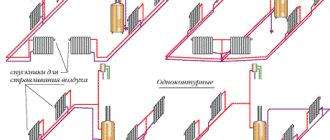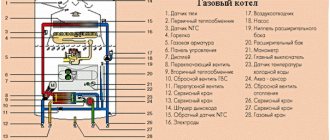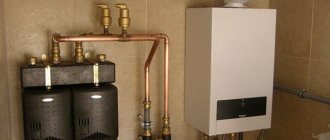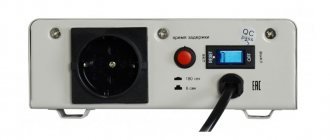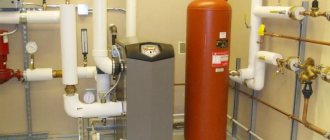It would be better to entrust the installation of a heating system to a private home to professionals, since they are already familiar with all the subtleties and nuances that can be encountered during installation. Our specialists will also help you with the choice of equipment and will be able to complete all the work on a turnkey basis. We contacted the AquaHit company to find out in more detail about heating schemes for a private home.
A private cottage that is not connected to the central heating main must be equipped with its own heating system. An autonomous heating system can be one-pipe or two-pipe. The first is more economical and easier to install, but less efficient in operation. More popular now is a two-pipe heating system for a two-story house, the design of which involves the parallel connection of all radiators and the presence of a return riser.
The difference between one and two-pipe heating schemes Source timber-ok.ru
Air is a more economical alternative to water
The obvious advantage of a heating scheme for a two-story house using ordinary air is its efficiency.
It is believed that such a system is not very universal, since if the air supply is cut off, the building will quickly cool down. But what happens if the water suddenly turns off? That's it. There is always a risk of breakdown. Unfortunately, there are no systems that work forever. There are two types of air-based heating - forced and gravity ventilation. If you choose the latter, the air will move due to natural circulation, which arises due to the temperature difference in the passage areas. The disadvantage lies in the following - due to the penetration of cold into the premises through windows, doors and other elements of the structure, the air flow is disrupted. The result is that the upper part of the rooms heats up, while the lower part, on the contrary, cools down.
With forced ventilation, things are a little different. Air circulates reliably thanks to fans. Through some openings it enters the premises and then is blown out through others. There are also disadvantages. For example, equipment often creates noise that interferes with concentration or sleep.
How to make the right choice
How to choose a gas boiler for a private home? There are many models from different manufacturers on sale. But in order to correctly assess which technical device is most suitable, you need to have the following information:
know the parameters of the heated area; take into account the overall dimensions of the room for placing equipment; take into account: is there a central water supply; take into account the intended location: on the wall or on the floor; compare cost and quality parameters.
The equipment can be single- or double-circuit, wall-mounted or floor-mounted, with natural or artificial smoke removal.
Single-circuit boilers provide heating for the entire area, and to heat additional water, you need to connect a boiler. Double-circuit systems simultaneously perform two functions: heating areas and heating the coolant water.
Devices with natural smoke removal have structural elements: a chimney and an open combustion chamber. Equipment with artificial smoke removal is equipped with a special fan (turbine) to provide forced ventilation.
Features of heating a two-story house
The biggest feature of the heating system in a two-story house is the rise of the coolant to a certain height. But in all other respects, this is a normal circuit, which contains a heating boiler, radiators, a pipe system, shut-off valves, an expansion tank and monitoring and control devices. If you select all the components of the system correctly, the heating will work like a Swiss watch
And it doesn’t matter what fuel the equipment operates on - it all depends on the correct configuration
Basic heating schemes
According to design features, the heating system of a two-story house can be divided into several types:
- Single and double pipe.
- With top or bottom wiring.
- With horizontal or vertical risers.
- With natural or forced coolant circulation.
- With main or dead-end coolant movement.
Connecting the system to the boiler
As you can see, there are many options, but among them there is one that combines all types and is optimal. This is a forced circulation circuit
It doesn’t matter what shape you choose for your own home. By installing a circulation pump in the system, you solve all problems at once. Therefore, many country developers try to make do with little effort and choose a low-cost option for pipe routing, thereby saving on the purchase of pipes and shut-off valves, as well as on installation work
Therefore, many country developers try to make do with little effort and choose a low-cost option for pipe routing, thereby saving on the purchase of pipes and shut-off valves, as well as on installation work.
Why does forced circulation avoid any problems? The fact is that the circulation pump creates a slight pressure inside the pipe system, which helps distribute the coolant evenly. Hot water moves at a speed higher than that of natural circulation, but at the same time this speed allows the water in the heating boiler to be heated efficiently. With such a system, it becomes possible to achieve effective distribution of coolant throughout all radiators.
Choosing a heating scheme
Of the various pipe routing schemes, the single-pipe system is rarely used in two-story houses. The reason is the inconvenience of regulating the heat transfer of a separate heating device. And when carrying out repairs, you have to turn off the entire system completely and drain the coolant, which leads to the rapid cooling of the house. That is why experts prefer a two-pipe scheme.
The latter is universal and practical in all respects. After all, the design of the pipe circuit involves connecting each radiator to two separate lines - supply and return. And if you install a control tap or valve, then each device can be adjusted to increase or decrease the temperature. This has recently become an important factor influencing energy savings. For example, at night there is no need to heat some rooms. It is possible to reduce the coolant supply gap in them on radiators, and heat consumption will immediately decrease, which will reduce the fuel supply to the burner of the heating boiler.
Connecting pipes to the boiler
But of all the presented pipe routing schemes, the collector one is considered optimal. Why? There are several positions that indicate the effectiveness of this scheme:
Firstly, one vertical riser extends from the heating boiler, which can be located on the ground floor or in the basement. The crown of the riser is the collector itself and the expansion tank. If we talk about the collector, then this is a pipe assembly that distributes the coolant throughout the heating batteries. At the same time, hot water flows into each device at the same temperature. Secondly, control valves are installed in the manifold. Not on the radiators, but on the manifold outlet pipes. So the node is not only distribution, but also regulating. There is no need to run around the rooms and adjust the coolant supply to each radiator - everything is located in one place, which is very convenient. Thirdly, with a collector system it is possible to carry out hidden piping. The collector unit itself and the expansion tank can be located in the attic and the circuits can be lowered from there, hiding them in the walls. This allows for improved interior design, which attracts consumers
But make sure that the attic is heated. If this condition is not met, then a number of measures will have to be taken to insulate the equipment.
Heating wiring diagrams
In two-story houses, the following heating distribution schemes are used: single-pipe, two-pipe, and also collector. With a single-pipe system, it is quite difficult to regulate the temperature in the building. This occurs because it is not possible to turn off one of the radiators when all other heating devices are working. Therefore, when hot water passes from one battery to another, it cools more and more.
Since each heating unit has two pipes, hot water flows through one, and cooled water through the other. This system also differs from a single-pipe system in that it has a different procedure for connecting heating devices. Experts recommend installing a control tank in front of each radiator.
Scheme of a two-pipe heating system
In order for there to be normal circulation in a two-story house, there is enough distance between the center of the boiler and the top point of the supply line, and you can install the expansion tank on the top floor, and not in the attic. And the supply pipe is laid under the ceiling or under the window sills.
Therefore, it is recommended to install an additional bypass along with the circulation pump, which will significantly save time when starting a system such as a heating scheme for a two-story country house, and at the same time, heat will be more evenly distributed in the building.
Heating circuit with bypass and pump
In addition to installing radiators, in a two-story house using a boiler together with a built-in circulation pump, you can install a “warm floor” system and connect a heated towel rail on two floors simultaneously. Experts advise connecting the risers on the second floor near the boiler itself.
When performing installation, it is best to use a radial and collector system; it is the most convenient; you can regulate the temperature in all rooms. For all heating devices, two pipes are installed: forward and return
Collectors are placed on each floor; it is very important that they are located in a specially designated cabinet, in which all shut-off valves are located
Combined heating system: radiators and heated floors
Collector systems
This is a universal heating scheme for a two-story house, a video on the design of which can be viewed below. Such systems make it possible to heat a two-story cottage with hidden pipes. Installation is very easy, so even a person without special skills can do it.
Scheme of collector heating of a two-story house
Water heating can be carried out either on one floor or on all of them at once, but it is recommended to place the boiler only on the first floor, and an expansion tank can be placed on the second. It is recommended to lay hot water pipes under the ceiling or under the windowsill, that is, in the most vulnerable places to cold air. It is imperative to install a separate control valve for each radiator. When choosing a heating plan for a two-story house, a very important point is to make the right decision; this determines how comfortable you will be in cold weather, how long the entire heating concept for a two-story house will last, how often it will be necessary to make repairs or change pipes, and much more. If you make the wrong choice, if you want to save now, it may happen that you will have to constantly repair, change, hire workers, and therefore spend money, so there is no question of any savings in this case.
https://youtube.com/watch?v=vBKn-xBFBiY
It’s better to install high-quality pipes, radiators and other things at the very beginning, although it will cost more and more now, but it will last longer and will still be cheaper in the future. A properly installed heating system for a two-story house made from high-quality, sustainable materials will last for several generations.
Electricity is a worthy replacement for gas due to its absence
Economical, efficient heating of a private home or cottage without gas should be more focused on maintaining familiar living conditions.
The level of comfort determines the choice of an alternative heating method, and today’s technology provides ample room for maneuver. The availability of electricity will allow you to achieve gas savings in the cold season. It is not without reason that many owners of country houses and country cottages, due to the lack of technical capabilities for connecting to the gas main, prefer electric heating systems. Compared to other heating devices, electric heating devices have almost 100% efficiency. An electric boiler is easy to maintain and inexpensive. In this case, there is no need for exhaust hood and chimney equipment
Electricity remains the most affordable alternative to gas heating today, taking into account efficiency and ease of maintenance
In addition to installing an electric boiler for a water heating system in a house, convectors, heat guns and infrared emitters are actively used to heat small residential buildings. The installation of heated floors in a private home is becoming a fashionable phenomenon today. The technology is quite new, however, it has already proven its effectiveness. The variety of heat sources offered gives you the opportunity to make a choice as to how best to heat your home.
In the event that a heated floor is your main source of heating residential premises, the power of the equipment should be 150-180 W per m2 of living space. Warm floors must have an area of at least 70-80% of the total area of the building itself. Otherwise, the expected heating effect will be negligible.
When heating a private home using other methods, you can achieve even higher economic indicators. Without gas, an economical and uninterrupted source of thermal energy in your area can be obtained using a heat pump. The operating principle of the equipment is based on the difference in temperature, deep in the soil and on the surface. With the help of a heat pump, which really costs a lot of money, you can provide yourself with an almost eternal source of heat in a country house. The effectiveness of this system is confirmed by simple calculations. An indicator of the successful operation of a heat pump is the heat conversion coefficient (COR).
Eg. When a heat pump consumes 1 kW of electricity necessary to ensure the operation of the entire system (Htn), the heat conversion coefficient (COP) is 3.0, which means:
Rtn x COP = 3 kW Rp energy output. The savings and efficiency of this heating method are more than obvious.
There is no clear answer to the question whether it is more profitable to heat a private house with gas or other types of fuel. In each individual case, the presence of a variety of factors plays a role, not least of which are the economic and technical capabilities of the consumer.
Instead of gas for heating, you can use almost any fuel. Another thing is how well you can fully heat your own home in cold weather and create comfortable living conditions for yourself. When faced with a situation like this, the choice is yours. How to save money and make your heating costs optimal depends on you, on your attitude to the very fact of saving energy and technical capabilities.
- Design and calculation of a brick fireplace with your own hands
- How to lay and insulate heating pipes in the ground?
- Why do you need a plinth for heating pipes?
- Selecting ribbed registers, radiators and heating pipes
- How to hide a heating pipe?
Expansion tank for closed heating system
The expansion tank is designed to compensate for changes in coolant volume depending on temperature. In closed heating systems, this is a sealed container divided into two parts by an elastic membrane. At the top there is air or inert gas (in expensive models). While the coolant temperature is low, the tank remains empty, the membrane is straightened (picture on the right).
Operating principle of a membrane expansion tank
When heated, the coolant increases in volume, its excess rises into the tank, pushing back the membrane and compressing the gas pumped into the upper part (in the picture on the left). This is displayed on the pressure gauge as an increase in pressure and can serve as a signal to reduce the combustion intensity. Some models have a safety valve that releases excess air/gas when a threshold pressure is reached.
As the coolant cools, the pressure in the upper part of the tank squeezes the coolant out of the container into the system, and the pressure gauge readings return to normal. That's the whole principle of operation of a membrane-type expansion tank. By the way, there are two types of membranes - disc-shaped and pear-shaped. The shape of the membrane does not affect the operating principle in any way.
Types of membranes for expansion tanks in closed systems
Volume calculation
According to generally accepted standards, the volume of the expansion tank should be 10%!o(MISSING)t of the total coolant volume. This means that you must calculate how much water will fit in the pipes and radiators of your system (it is in the technical data for radiators, and the volume of the pipes can be calculated). 1/10 of this figure will be the volume of the required expansion tank. But this figure is only valid if the coolant is water. If a non-freezing liquid is used, the tank size increases by 50%!o(MISSING)t of the calculated volume.
Here is an example of calculating the volume of a membrane tank for a closed heating system:
the volume of the heating system is 28 liters; expansion tank size for a system filled with water 2.8 liters; the size of the membrane tank for a system with non-freezing liquid is 2.8 + 0.5 * 2.8 = 4.2 liters.
When purchasing, select the nearest larger volume. Don't take less - it's better to have a small supply.
What to look for when purchasing
There are red and blue cans in stores. Red tanks are suitable for heating. The blue ones are structurally the same, only they are designed for cold water and cannot tolerate high temperatures.
What else should you pay attention to? There are two types of tanks - with a replaceable membrane (they are also called flanged) and with a non-replaceable one. The second option is cheaper, and significantly, but if the membrane is damaged, you will have to buy the whole thing
For flanged models, only the membrane is purchased.
Place for installing a membrane type expansion tank
Usually they place an expansion tank on the return pipeline in front of the circulation pump (if you look in the direction of flow of the coolant). A tee is installed in the pipeline, a small section of pipe is connected to one part of it, and an expander is connected to it through fittings. It is better to place it at some distance from the pump so that pressure differences are not created. An important point is that the piping section of the membrane tank must be straight.
Installation diagram of an expansion tank for membrane-type heating
A ball valve is installed after the tee. It is necessary to be able to remove the tank without draining the coolant. It is more convenient to connect the container itself using an American nut. This again makes installation/disassembly easier.
The empty device does not weigh much, but when filled with water it has a significant mass. Therefore, it is necessary to provide a method of mounting on the wall or additional supports.
The heating expansion tank can be hung on a bracket
Make a support platform
The tank on legs can be installed on the floor
Pediment - do it yourself
Making a pediment with your own hands is no more difficult than the construction of other vertical enclosing parts of the building. But this is only the case when there is certain construction experience and qualifications. In their absence, it is better to start self-training in construction by setting up a barn or garage.
You will also need to remember the school course in Euclidean geometry. This will be required in order to correctly mark at least two identical parts of a house of a triangular or more complex shape. They are usually spaced from one another at a distance of 10 meters or more. And all this needs to be done using a cord, a plumb line, bubble and water levels. Otherwise, if there are errors in the markings, you will end up with a curve shifted to one side, a roof with a ridge skewed in the vertical and horizontal plane.
Classic style
Advice It is not recommended to carry out work on the installation of gables alone. It is better to invite one or two assistants. Adult relatives, acquaintances or neighbors can be used in this capacity.
If difficulties arise during marking, call a surveyor. He, having at his disposal geodetic instruments - a level and a theodolite and others, will be able to correctly carry out the breakdown, but will ask for some money for it.
Hallway with Shelves for shoes and clothes Do it yourself: 125+ Photos of options (with a seat, with a hanger, with a banquette and more)
Zoning
Designers do not advise giving in to fashion trends and copying design ideas without taking into account dimensions, location and other nuances. Before planning and arranging furniture, every detail is thought through. There are several simple rules that experts advise you to follow:
- Let the room have natural light. To do this, remove excess walls (except for load-bearing ones).
- If the rooms in the apartment are small (12 sq. m or 16 sq. m), the layout of the kitchen combined with the dining room will be the right solution.
- If the ventilation system is not designed correctly, the smell of food will spread throughout the apartment.
Furniture items
A few examples of furnishing a kitchen combined with a living room:
- 1. Sofa. It becomes an object that zones space. The sofa is placed with its back facing the place where food is prepared. In small rooms (less than 20 sq m) a corner is placed, which is placed against a wall installed perpendicular or parallel to the kitchen.
- 2. Set. According to designers, minimalist models without elaborate details look modern. The service, vases or glasses are placed on an open shelf. You can buy a fashionable display case for them. Furniture is placed near the wall. If the space is large (20 sq. m, 25 sq. m or 30 sq. m), then in the central part you can install an island, which also has sections for kitchen appliances.
- 3. Furniture set. The style should be combined with the design of both rooms. In small rooms, a compact table and chairs made of transparent material or painted in light colors look good. You can add a table with a round top to your living room interior. In spacious rooms, the kit is installed near the wall or in the central part. An elongated rectangular dining table would look good here.
Wiring systems for two-story houses
To heat two-story houses, you can use one-, two-pipe and manifold wiring. If you choose a project with a single-pipe system, then adjusting the temperature in the rooms will be quite a difficult task, since it is impossible to shut off one of the radiators while other devices are operating. It involves sequential circulation of coolant from device to device.
As for the two-pipe one, it is more versatile and ideal for heating a private two-story house. The implementation of such a system is simple - two pipes are connected to each device in the heating system - one of them is responsible for supplying hot water, and the second one discharges cooled water. But unlike a single-pipe system, this scheme differs in the order in which the heating units are connected, and therefore, in order to increase its efficiency, experts recommend installing a control tank in front of each radiator.
Regardless of the size of the house, for a 2-story building there will be enough distance between the top point of the supply line and the center to ensure normal water circulation. Thus, installation of an expansion tank will be possible not only in the attic, but also on the top floor. And the pipes themselves can be mounted under window sills or ceilings.
In addition, a two-pipe system with a circulation pump also allows you to implement a “warm” floor system, as well as connect heated towel rails on each floor and other devices of this class. But more about them later.
Replacing old equipment
To replace the boiler you need to do the following:
- Write an application to the gas service at your place of residence.
- After waiting for a written response, collect documentation: equipment passport, inspection reports and other documents.
Dismantling of the old boiler is carried out according to the following scheme:
- Flushing the heating system and draining the coolant.
- Disconnecting the boiler from the gas source, heating and ventilation system.
- The boiler should be removed from the room.
To install a new boiler, you should get advice from gas service workers about the need to purchase additional materials.
Afterwards, notify the gas workers in writing that you are ready to install the equipment, and invite them to carry out the work.
Open and closed heating systems
The operation of an open heating system is carried out in many apartment buildings. For this, a special expansion tank is used. During operation, excess ends up in this container. The system may not be tight, so the whole process is accompanied by evaporation of vapors. The open version does not include a built-in pump. The installation design is quite simple and easy.
- uniform heating of the room;
- ease of operation;
- durable;
- the system can operate even when the electricity is turned off;
- no need to install an additional pump;
The closed heating system is completely sealed and does not emit vapors during operation. The movement of the water flow is carried out using a pump. There is no natural circulation in this system. If excess water begins to appear, the valve is activated and the liquid evaporates to reduce the water level.
Advantages of the closed type:
- reliability and strength;
- the ability to adjust the pressure level in the system;
- availability;
- resistant to low temperatures;
- the ability to use additional heaters;
Options for a two-pipe system
The main difference between a two-pipe heating scheme for a private house is the connection of each battery to both direct and reverse current mains, which doubles the pipe consumption. But the home owner has the opportunity to regulate the level of heat transfer of each individual heating device. As a result, it is possible to provide different temperature microclimates in the rooms.
When installing a vertical two-pipe heating system, the lower as well as the upper heating distribution diagram from the boiler is applicable. Now in more detail about each of them.
Vertical system with bottom wiring
Set it up as follows:
- From the heating boiler, a supply main pipeline is run along the floor of the lower floor of the house or through the basement.
- Next, risers are launched upward from the main pipe, which ensure that the coolant enters the batteries.
- A return flow pipe departs from each battery, which carries the cooled coolant back to the boiler.
When designing the lower wiring of an autonomous heating system, the need to constantly remove air from the pipeline is taken into account. This requirement is met by installing an air pipe, as well as installing an expansion tank, and using Mayevsky taps on all radiators located on the top floor of the house.
Vertical system with top wiring
In this scheme, the coolant from the boiler is supplied to the attic through the main pipeline or to the very ceiling of the upper floor. Then the water (coolant) goes down several risers, passes through all the batteries, and returns back to the heating boiler through the main pipeline.
To periodically remove air bubbles, an expansion tank is installed in this system. This version of the heating device is much more effective than the previous method with lower pipe routing, since higher pressure is created in the risers and radiators.
Horizontal heating system - three main types
The installation of a horizontal two-pipe autonomous heating system with forced circulation is the most common option for heating a private home. In this case, one of three schemes is used:
- Dead end circuit (A). The advantage is the low pipe consumption. The disadvantage lies in the large length of the circulation circuit of the radiator farthest from the boiler. This makes it very difficult to adjust the system.
- Scheme with associated movement of water (B). Due to the equal length of all circulation circuits, it is easier to adjust the system. During implementation, a large number of pipes will be required, which increase the cost of work and also spoil the interior of the house with their appearance.
- Scheme with collector (beam) distribution (B). Since each radiator is connected separately to the central collector, it is very easy to ensure uniform distribution of all rooms. In practice, heating installation according to this scheme is the most expensive due to the high consumption of materials. The pipes are hidden in a concrete screed, which greatly increases the attractiveness of the interior. The radial (collector) floor heating distribution scheme is becoming increasingly popular among individual developers.
This is what it looks like:
When choosing a standard wiring diagram, it is necessary to take into account many factors, ranging from the area of the house to the materials used in its construction. It is better to resolve such issues with specialists to eliminate the possibility of error. After all, we are talking about heating the house, the main condition for comfortable living in private housing.
Autonomous sources of electricity
When deciding what is the best way to heat a house if there is no gas, some owners of private households use original technical solutions.
The most economical heating of a private house without gas is to use autonomous sources of electrical energy:
- Solar energy. To convert solar energy into electrical energy, you will need special solar collectors. This will allow the use of an autonomous heater that does not depend on mains electricity. The main thing in this case is to find finance to purchase the necessary equipment. In the future, electrical energy will be supplied to the home practically free of charge.
- Wind energy. It can also be converted into heat to heat your home without gas. This happens inside a special unit that converts mechanical energy into electrical energy. Some craftsmen assemble such structures with their own hands. This is not so difficult to do, since the converter includes only three parts - a windmill, a battery and a generator. All that is required is to correctly connect these devices to each other. It is especially beneficial to use wind power generators in uninhabited, well-ventilated areas located away from gas fields. If you have not yet decided how to heat your house if there is no gas, it is worth considering this option.
Partitions
The interior of the kitchen and living room begins to be thought out from the junction of the two zones.
- Here are some of the ways and objects that delimit space:
- installation of a bar counter;
- kitchen island;
- big table;
- installation of a low partition.
Designers advise installing a wide counter, since you can sit at it like at a regular table, and high chairs are quite suitable for the whole family. However, in small rooms (16 sq m), narrow counters are installed. Kitchen islands are convenient to use, but are only suitable for large kitchen-dining rooms (25 sq m or 30 sq m). Capital low partitions are installed only if it has been decided in advance what they will be used for (for example, as a TV stand).


